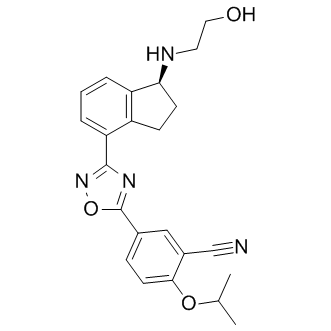| Description: |
Ozanimod is a potent and selective S1P1 and S1P5 receptor agonist with EC50s of 410±160 pM and 11±4.3 nM in [35S]-GTPγS binding, respectively. |
| In Vivo: |
Ozanimod (RPC1063) is specific for S1P1 and S1P5 receptors, induces S1P1 receptor internalization and induces a reversible reduction in circulating B and CCR7+ T lymphocytes in vivo. Ozanimod shows high oral bioavailability and volume of distribution, and a circulatory half-life that supports once daily dosing. Oral Ozanimod reduces inflammation and disease parameters in all three autoimmune disease models[1]. |
| In Vitro: |
Ozanimod (RPC1063) is a potent sphingosine-1-phosphate receptor-1 (S1P1) and receptor-5 (S1P5) agonist. The EC50 values are subnanomolar for S1P1 receptors whether measuring inhibition of cAMP generation (160±60 pM) or [35S]-GTPγS binding (410±160 pM). The EC50 value for S1P5 receptor whether measuring inhibition [35S]-GTPγS binding (11±4.3 nM). Ozanimod demonstrates agonist activity at the S1P5 receptor [11±4.3 nM and 83% Emax (percentage of maximum stimulation)]. To determine whether Ozanimod induces sustained S1P1 receptor internalization, S1P1 receptor-HEK293T cells are incubated with different doses of Ozanimod in the presence of 10 μM cycloheximide to prevent translation of new S1P1 receptor protein. Cells are analysed after 1 h treatment, or, after the 1 h treatment washed thoroughly to remove Ozanimod and incubated with 1 μM Cycloheximide for a further 24 h. After a 1 h treatment Ozanimod induces significant loss of S1P1 receptor cell surface expression, similar in magnitude and potency to that seen with FTY720-P-treated cells. Following 1 h of treatment and a 24 h washout period, Ozanimod demonstrates a dose-dependent effect on S1P1 receptor re-expression on the cell surface, with near complete and sustained loss of cell surface receptor expression at concentrations above 10 nM[1]. |






















